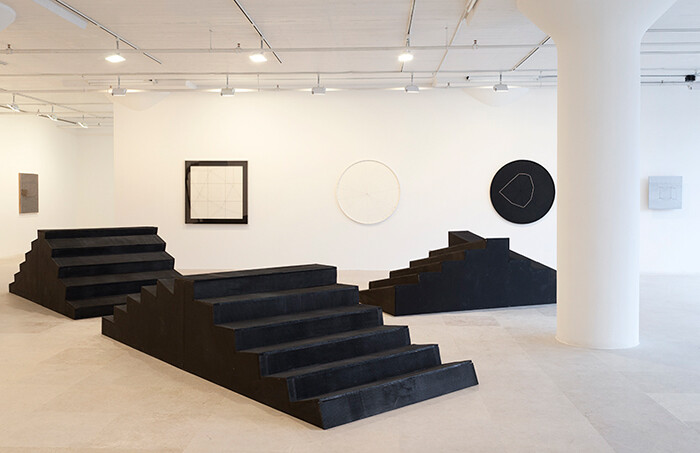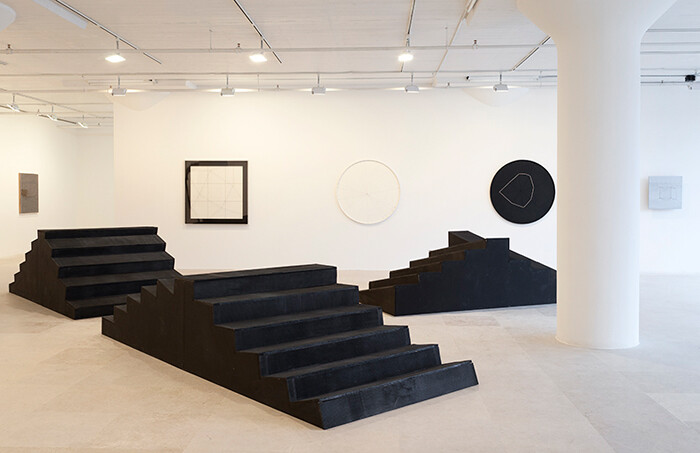I don’t know if I’ve ever seen—and experienced—as much unadulterated glee in an art gallery or museum as I did at the opening of Gelitin’s “The Fall Show” at Greene Naftali last September. The gallery was filled with makeshift sculptures of different shapes fashioned from relatively cheap materials and placed on variously sized pedestals. Each pedestal had a foot pedal attached that rocked or jolted it, sending the sculpture perched on top crashing to the floor, usually with a loud thud or a sharp clatter. Some of the sculptures were dented and chipped by the end of the evening, and I can only imagine their condition by the close of the show. At the opening and in the weeks that followed, people took iconoclastic pleasure in toppling Gelitin’s artworks, which seems appropriate given the aura of exclusivity that still generally surrounds art (and its institutions), even after a decade or more of frequently overheated rhetoric—pro and con—regarding participatory and interactive art (along with its kissing cousin, relational aesthetics). In certain ways, Gelitin’s show felt like an absurdist exclamation mark emphatically inserted into this debate.
The much quieter, although not entirely silent, current exhibition at Greene Naftali follows participatory and interactive art back to a largely unacknowledged precursor, the Italian artist Gianni Colombo (1937–1993). In the 1950s and 1960s, this kind of work was called Kinetic art; but these days, revisionist art-historical discourse tends to downplay the formal for the social dimension. Following a retrospective organized by Carolyn Christov-Bakargiev at Turin’s Castello di Rivoli in 2009, Colombo’s first solo show in the United States features selections from three decades worth of work before he moved more exclusively toward architecture in the 1980s. Thus, some of the chronologically most recent pieces on display are small-scale models of built environments, one of which, Spazio Elastico (1968), consists of a dark, room-sized cube illuminated by black lights and crisscrossed with elastic cords that form a swaying grid large enough to walk through. When installed at the 1968 Venice Biennale, it won the top prize for painting, a fitting achievement for Colombo and his fellow members of Gruppo T, who exhibited in Italy from 1959–1962, and whose goals were the blurring of artistic mediums and increased viewer participation.
This is apparent at Greene Naftali where much of the work on display superficially resembles painting. Upon closer inspection, these are “paintings” made with elastic string, polystyrene blocks, foam, felt, and fabric, a few of which have knobs and levers attached that allow the viewer to adjust their materials. For instance, Superficie Pulsante (1959) consists of a small wooden frame filled with slices of polyurethane foam that pucker forward and back when a little knob is turned. The larger Superficie in Variazione (1959) features a row of metal levers at the bottom that when pulled create indentations in the fuzzy surface fabric. Two of the works move on their own via motors, the sounds of which fill parts of the gallery with a low whir. Strutturazione Pulsante (1959) gently pushes blocks of vertically aligned polystyrene away from the picture plane in a seemingly random pattern. A companion piece of sorts to the installation sharing its name, Spazio Elastico (1966–1967) makes nine, long strands of white elastic cord wiggle right and left in unison against a black background.
With a little encouragement from gallery staff, strings of elastic on a number of the paintings can be moved across the work’s surface, allowing viewers to create their own geometries. Alongside these interactive features, many of the pieces anticipate Arte Povera in their use of common, everyday materials (including Colombo’s earliest work on display, a set of ceramics, a few of which were meant to be turned by hand on their vertical axes). Colombo expanded this nudging of art into life—and vice versa—with his participatory installations. Along with the aforementioned models, a fully realized companion piece anchors the exhibition. Bariestesia delle scale (1974–1975) includes three sets of ascending and descending steps, each slightly tilted or pitched so that walking over them is somewhat difficult, making you feel a bit tipsy. Besides extending the artwork beyond the modernist regime of the purely optical, the proprioceptive experience in this and related works is meant to instigate a more substantial awareness of durational time.
Yet the steps aren’t so off-center that gallery-goers need to sign a waiver, as is occasionally now the case when experiencing interactive art, and the range of participation available with Colombo’s work is relatively limited. Unlike other earlier practitioners of participatory art such as Hélio Oiticica and Lygia Clark, both of whose work feels more fluid and permeable in comparison, Colombo sticks much closer to the grid (as does his German contemporary Franz Erhard Walther). This isn’t unrelated to the way bodies traversed new social spaces produced by the architecture and urban design of European post-war rebuilding efforts within a solidifying capitalist system. As historical understanding radically contracts to the present’s all-consuming maw (witness the New Museum’s current “1993” exhibition as historical survey, and the fact that contemporary art is the most rapidly expanding field in professional art history), this carefully curated mini-retrospective of Colombo’s work helps push a sense of history back outward.







